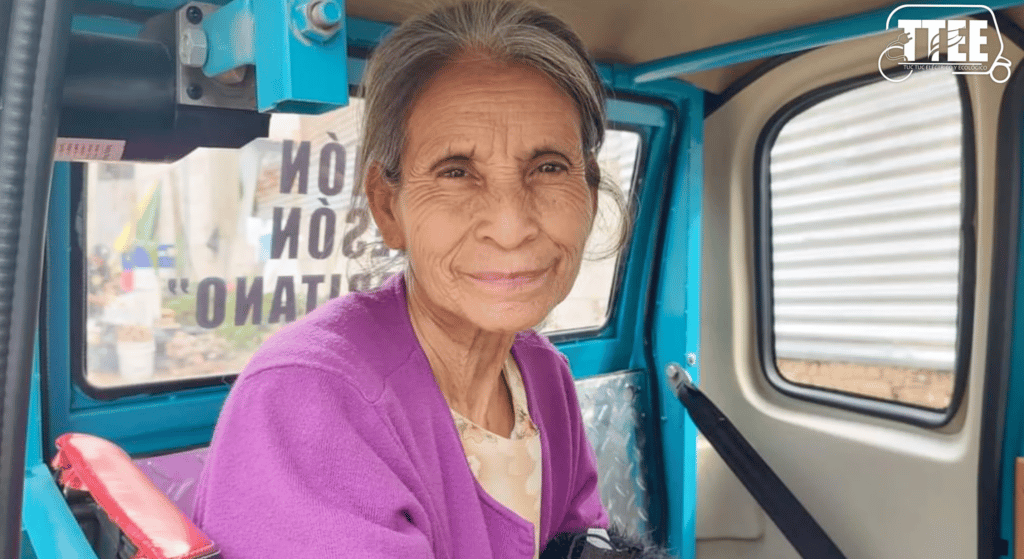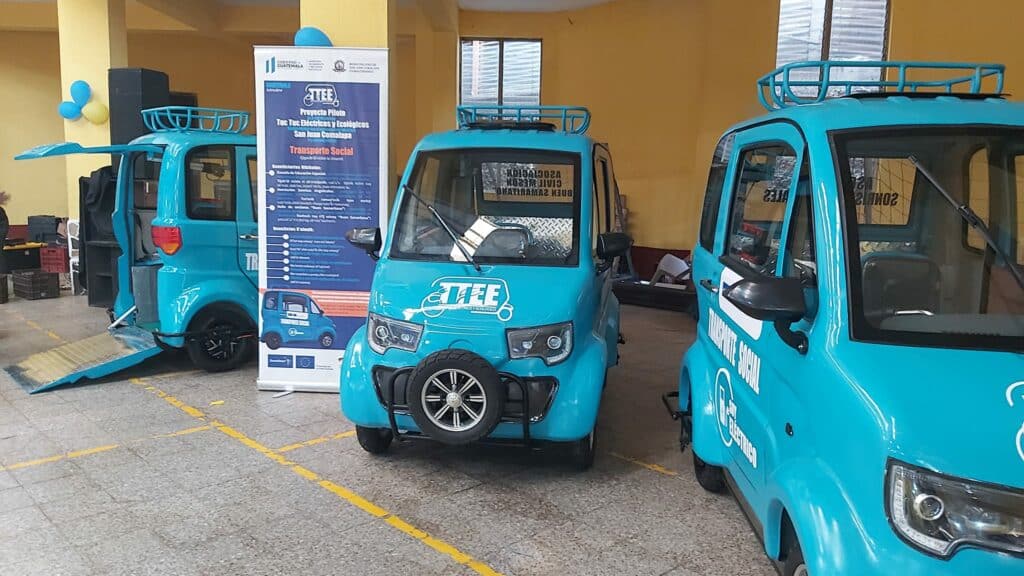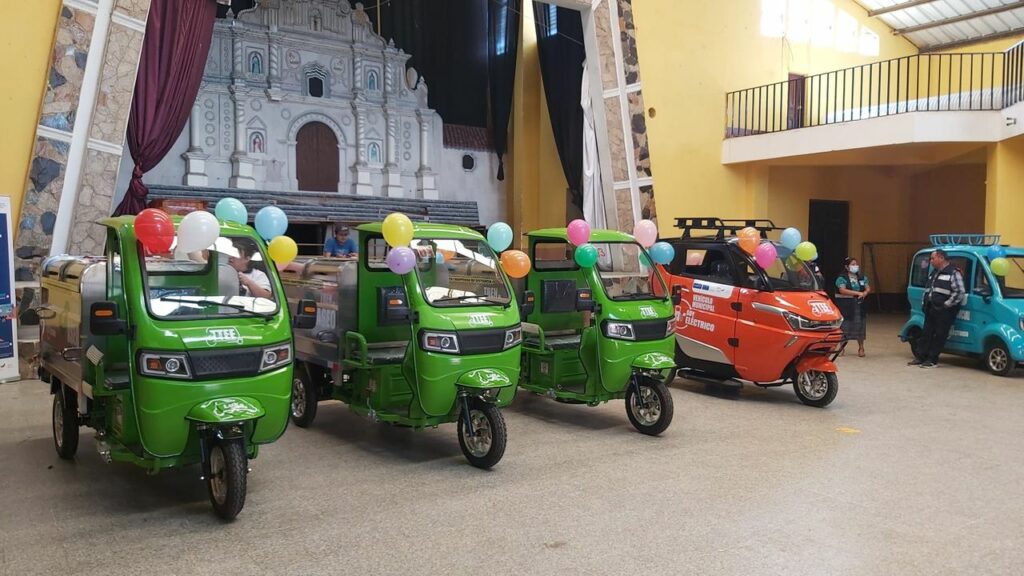
This article is part of our #StoriesofChange where we profile the work of our partner countries in developing climate actions in transport. Read more #StoriesOfChange and follow the Hashtag on Twitter.
Defining mobility patterns is important, but what happens when not all modes are included, and patterns are not differentiated by gender?
Traditionally, family roles are highly genderized; therefore, women mostly fulfil household and care activities. This implies different mobility solutions for women and men, as women tend to take several trips per day to complete various caretaking and housekeeping activities.
For example, in San Juan Comalapa, Guatemala, women travel significantly more often by tuk-tuk (25%) than men (6%). In contrast, men use bicycles for 20% of their trips. Moreover, 11% of the population has difficulties accessing urban mobility services. This is the scenario is not very different from the reality in many other small cities in Latin America.
The Electric Tricycle Pilot project, which is part of the EUROCLIMA+ Programme, allowed us to introduce electric transport to boost the renewal of old petrol-powered tuk-tuks, to increase the accessibility of public transport, improve solid waste management in areas of the municipality that are difficult to access, and to provide public transport service to people in vulnerable situations who so far used to receive a poor service or simply didn’t received it at all.
The project was completed in May this year and also included capacity building in matters of climate change, sustainable mobility and gender in order to become a good example in the region and to be able to replicate in other areas of the country or even in the region, where there are no similar examples.
This is the story of how San Juan Comalapa introduced electric tuk-tuks to improve transport services in a more sustainable way in their community, whose population belongs to the indigenous Kaqchiquel community.

In 2018, the journey for the implementation of the pilot project began. Meetings were held with the association of tuk tuk owners where 3 women, owners and pilots of units, participated as well. In the first workshops, an attempt was made to define the route for the implementation of the electrical units.
However, the doubt and skepticism of the operation of the electrical units by the members of the tuk tuk association were always an important factor within the project. Building trust in electric mobility is one of the challenges we have to face, as today there are still cultural barriers to its implementation.
To achieve a good implementation, it was necessary to carry out a series of base studies with the intention of knowing the situation of mobility in San Juan Comalapa, as well as knowing examples of similar projects in Latin America and knowing the market for electric tricycles in the region.

In the same way, a study trip was made to Mexico with the intention of knowing examples of electric tricycles already successfully implemented and in this way being able to know the advantages and disadvantages, the different business models and the technical specifications of the units to be able to ensure their successful operation.
With the arrival of the pandemic, the project implementation process slowed down. Sanitary measures in Guatemala were strict, so the possibility of carrying out activities became extremely complicated. San Juan Comalapa is a rural municipality, so there was no internet everywhere and a large part of the population does not have internet at home, so holding online workshops or seminars was not an option.
However, once the sanitary measures were reduced, it was possible to learn more about the beneficiaries of the units for people with disabilities and we were able to understand the limitations with which they currently moved and the benefits they would obtain once they received the unit. It is also important to highlight the great work that mothers do to support their children to obtain education or therapies.
Understanding the uses and customs of the community of San Juan Comalapa, and how these are linked to the dynamics of mobility, was a very valuable process for us. To make people aware of the project, communication materials were produced in Kaqchiquel, as the following examples show:


Project implementation cannot be done in a top-down manner. Integrating people’s experiences and needs was an aspect we contemplated from the beginning. Although the pandemic slowed down the process, this phase was as important as other technical aspects such as the study of the geography of the municipality, the definition of the characteristics that the units should have and the financial analysis for their acquisition.
In May 2022, the presentation ceremony of the 2 electric units for public transportation, 4 units for solid waste collection and 3 for the transportation of disabled people, as well as the charging stations, was held.
You are currently viewing a placeholder content from Youtube. To access the actual content, click the button below. Please note that doing so will share data with third-party providers.
More InformationAlong with the delivery of the units, training workshops were held on the proper use of the units and their maintenance. A caravan –an important tradition in the community– was held to present the units, with the intention that the population of San Juan Comalapa become familiar with the units and feel part of the project.

The intention of having 2 units for public transport is that the tuk tuk association gets to knows the units, tests them and get convinced of their usefulness.

The units for disabled people were costume made, since it is possible to travel with a person in a wheelchair plus a companion, through a hydraulic ramp. These units were donated to schools and social organisations, who will make exclusive use of the units to transport the population they serve.

The solid waste collection units are intended to dignify the work, make it faster and more efficient.
Early inter-institutional coordination and capacity building are crucial. It is necessary to improve inter-institutional coordination when implementing this type of project, since there are many actors involved, and they are not necessarily trained in mobility projects.
Different entities were involved, such as the Ministry of Environment and Natural Resources, the Ministry of Education, as well as the waste collection department and other sectors involved in the execution of the project, which added complexities to its management.
We also emphasise the need for a respectful and empathetic approach to the community where the initiatives are implemented, as their involvement is crucial to ensure their success.
While this process was not easy, one lesson is to integrate community leaders into project decision-making and to generate horizontal communication campaigns that familiarise people with electric mobility and related issues.
In addition, we emphasised the importance of knowledge management and the collection and systematisation of information, a crucial step in pilot projects that seek to scale up.
The project was completed with the delivery of the electric tuk-tuks. San Juan Comalapa’s experience has been shared in different international forums and events, which has aroused great interest. A promising future in the implementation of electromobility projects can be foreseen in Guatemala.
The initiative has conditions for its scaling, but dissemination and marketing actions needs to be carry out. Electric tricycles may be used in more touristic municipalities such as Antigua and replicate the solid waste collection model. This responsibility can be carried by the Ministry of Environment and Natural Resources, which is in line with the recent energy transition and electric mobility policies that Guatemala has promoted at the national level.
On our side, we will continue to promote the lessons learned and share this story whenever we have the opportunity. In this way, we continue to promote electric mobility adapted to the Latin American context and reality.
It is now clearer to us that, in addition to contributing to the reduction of emissions in the transport sector, it is vital to provide decent mobility services that improve people’s lives and reduce social inequalities. The energy transition must be a just transition.

If you believe that you suffer (potential) negative social and/or environmental consequences from IKI projects, or wish to report the improper use of funds, to voice complaints and seek redress, you can do so using the IKI Independent Complaint Mechanism.
You are currently viewing a placeholder content from X. To access the actual content, click the button below. Please note that doing so will share data with third-party providers.
More Information